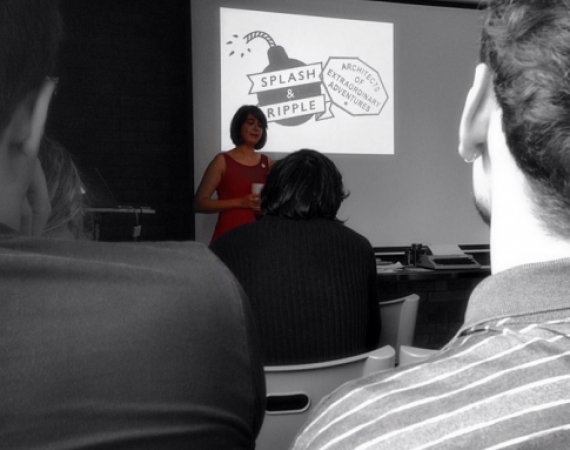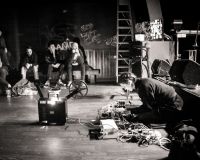Lunchtime talk write-up
Posted on Wed 4 Feb 2015
Hitting the Empathy Nerve Lunchtime Talk Write-up
Written by Jess, our projects coordinator at the time, who guest programmed the talk.Last autumn, resident Rosie Poebright introduced the fascinating premise behind the work of Splash & Ripple, who's mission is to make beautiful, genuinely moving experiences that put the participants at the…

Rosie talking about heightened experience and empathy in real world games and adventures. Photo @veritymcintosh
Posted by

Jasmine Butt
Jasmine is a musician, synth builder and AV artist who is currently exploring modular synthesis.Written by Jess, our projects coordinator at the time, who guest programmed the talk.
Last autumn, resident Rosie Poebright introduced the fascinating premise behind the work of Splash & Ripple, who's mission is to make beautiful, genuinely moving experiences that put the participants at the centre of the action. Here are some of the interesting insights shared at the talk.
It’s easy to scare people. Having worked on some very successful games that tapped into people’s fears, Rosie was looking for a new challenge and a new way of telling emotionally resonating stories. It was for these reasons she began exploring empathy…
We’re hard-wired for empathy. A 2010 study found that the vagus nerve, a bundle of nerves at the top of the spinal cord, plays a central role in humans’ tendencies towards kindness compassion. This nerve also activates many of the central organs of our body including the heart, lungs, liver, and the digestive organs.
The fact this nerve controls such basal systems as well as our ability to feel compassion has been used to suggest that empathy might be considered part of a set of hard-wired evolutionary responses.
Or in more simple terms, our capacity for compassion is part of a set of basic human functions. Now, I’ll concede that’s not all that revolutionary, but stay with me…
How can empathy make us better storytellers? Can we harness such responses to better tell stories, to uncover histories, and to breath life into buildings who‘s vibrant communities have long since been eclipsed by dry information panels and somewhat turgid audio tours? Splash & Ripple certainly think so.
We live in a distracted and interrupted world. Screens, notifications, and reminders jump at us from all directions. Now imagine there is a castle, and you have been asked to tell the story of that castle. How might you do it? If you’re doing it in person, you can use a range of basic tools to convey a story, for example you might alter your tone and pace to reflect different events. But how do you connect with an audience without having such direct contact?
This was the challenge Splash & Ripple faced when the National Trust approached them about creating a work for Bodiam Castle in East Sussex.
‘If you give someone a hammer, everything looks like a nail…’ Abraham Maslow
When faced with a familiar tool, whether it’s a hammer or an iPhone, we are conditioned to use it in a particular way. For this reason, Splash & Ripple believe that creating a tablet or smartphone based experience would have completely missed the point, and distracted visitors from the castle itself.
The result was A Knight’s Peril - an interactive fictional narrative informed by academic research. It makes use of cutting edge hardware and interactive software that responds to choices made by visitors, activating the appropriate audio scenes when touched to special seals hidden around the castle. All of the technology is hidden inside a convincing medieval artifact – an Echo-Horn.
Empathy can wake people up. When asked what inspired her to explore this form of storytelling, Rosie responded that her interest is in creating spaces for people to think actively and collectively: ‘You’re not throwing opinions at people, but putting them into a difficult situation, where they really have to weigh up outcomes and pay attention to how they feel. Each audience member should feel like they are a key protagonist in the story.’
Now I’d take an extraordinary adventure like that over a leaflet and an audio tour any day, and it should come as no surprise that Splash & Ripple describe themselves ‘Architects of Extraordinary Adventures.’
If you’d like to embark on A Knight’s Peril for yourself, you can find out more on the National Trust website.